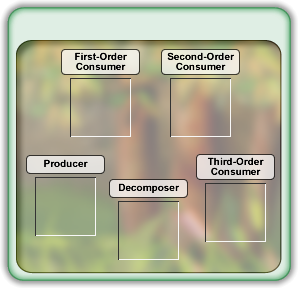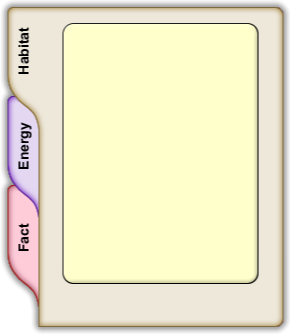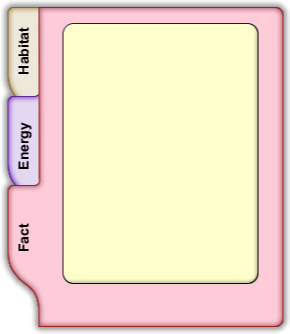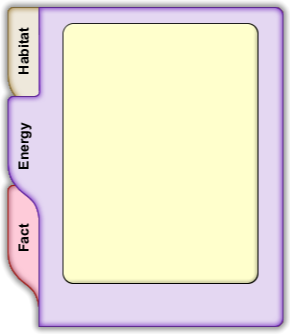VIRTUAL LABS
X
Ecology
How is energy transferred through a community of organisms?
Organisms interact with one another and with the abiotic factors of an ecosystem in various ways. Abiotic factors are the nonliving characteristics of the environment. Some examples of abiotic factors include temperature and rainfall. A desert ecosystem's abiotic factors include a small amount of rainfall and warm daytime and cool nighttime temperatures. A temperate forest's abiotic factors include an average amount of rainfall and a wide temperature range.
Some of the most important interactions among species in an ecosystem community involve feeding. All living things need food for energy. When one organism consumes another, energy is transferred from the organism that is eaten to the organism that eats it. Most of the energy an organism takes in is released as thermal energy. Only about 10 percent of the energy available at one level of a food chain transfers to the next.
A food chain models the transfer of energy through a biological community. Most food chains have four or five links, with each link representing a feeding step. Organisms are placed into a food chain according to their energy source. There are five levels in a food chain: producers, first-order consumers, second-order consumers, third-order consumers, and decomposers.
Producers obtain energy from the Sun or from chemicals in the environment. Plants, bacteria, and protists are examples of producers. First-order consumers, or herbivores, obtain energy by eating producers. Rabbits, geese, and termites are examples of first-order consumers. Second-order consumers, or carnivores, obtain energy by eating herbivores. Examples of second-order consumers include wolves, spiders, and frogs. Third-order consumers, or top carnivores, obtain energy by eating other carnivores. Lions, falcons, and killer whales are examples of third-order consumers. Decomposers feed at all levels of a food chain, obtaining energy by breaking down the decaying bodies and wastes of other organisms. Examples of decomposers include mushrooms and molds.
In this Virtual Lab, you will examine various organisms and determine their placement in a five-link food chain.
Objectives:
Procedure:
1. Click the Video button. Watch the video and observe how energy moves through a biological community. Write your observations in your Journal.
2. Click a stack of cards to examine five organisms from an ecosystem. The organisms are part of a desert or temperate forest community, and each organism is part of a five-level food chain.
3. Drag a card to the information display area in the upper right part of the screen. Click the appropriate tab along the top of the display area to read information about the organism. Use this information to determine the organism's place in the food chain.
4. Drag the card to its proper place in the food chain.
5. Repeat steps 3 and 4 with the remaining organisms.
6. To check your work, click the Check button. If an organism is sequenced incorrectly, it will be highlighted in red. Re-examine the organism's habitat, energy, and fact information, and then resequence the organism.
7. When you have correctly sequenced each organism in the food chain, record the organisms' names and placement in the Table.
8. Click the Reset button to construct a new food chain. Each organism may belong in more than one food chain.
9. Complete the Journal questions.
Some of the most important interactions among species in an ecosystem community involve feeding. All living things need food for energy. When one organism consumes another, energy is transferred from the organism that is eaten to the organism that eats it. Most of the energy an organism takes in is released as thermal energy. Only about 10 percent of the energy available at one level of a food chain transfers to the next.
A food chain models the transfer of energy through a biological community. Most food chains have four or five links, with each link representing a feeding step. Organisms are placed into a food chain according to their energy source. There are five levels in a food chain: producers, first-order consumers, second-order consumers, third-order consumers, and decomposers.
Producers obtain energy from the Sun or from chemicals in the environment. Plants, bacteria, and protists are examples of producers. First-order consumers, or herbivores, obtain energy by eating producers. Rabbits, geese, and termites are examples of first-order consumers. Second-order consumers, or carnivores, obtain energy by eating herbivores. Examples of second-order consumers include wolves, spiders, and frogs. Third-order consumers, or top carnivores, obtain energy by eating other carnivores. Lions, falcons, and killer whales are examples of third-order consumers. Decomposers feed at all levels of a food chain, obtaining energy by breaking down the decaying bodies and wastes of other organisms. Examples of decomposers include mushrooms and molds.
In this Virtual Lab, you will examine various organisms and determine their placement in a five-link food chain.
Objectives:
- Determine an organism's place in a five-link food chain.
- Explain how, and in what sequence, energy is transferred through different communities of organisms.
- Define abiotic factors and give examples of them.
Procedure:
1. Click the Video button. Watch the video and observe how energy moves through a biological community. Write your observations in your Journal.
2. Click a stack of cards to examine five organisms from an ecosystem. The organisms are part of a desert or temperate forest community, and each organism is part of a five-level food chain.
3. Drag a card to the information display area in the upper right part of the screen. Click the appropriate tab along the top of the display area to read information about the organism. Use this information to determine the organism's place in the food chain.
4. Drag the card to its proper place in the food chain.
5. Repeat steps 3 and 4 with the remaining organisms.
6. To check your work, click the Check button. If an organism is sequenced incorrectly, it will be highlighted in red. Re-examine the organism's habitat, energy, and fact information, and then resequence the organism.
7. When you have correctly sequenced each organism in the food chain, record the organisms' names and placement in the Table.
8. Click the Reset button to construct a new food chain. Each organism may belong in more than one food chain.
9. Complete the Journal questions.
















